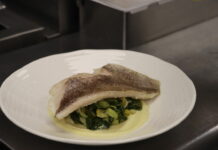In the early morning hours of July 3, after the last customers had left and the last crumbs of chef Cindy Wolf’s signature desserts had been swept away, the lights came up at Charleston.
The waiters, prep cooks and other employees changed out of their work clothes and into shorts and T-shirts. Then they set to work demolishing what many consider Baltimore’s finest restaurant.
They tore down the old, fussy draperies and removed the pineapple-print banquettes, the palm-frond accented carpeting, the apricot-and-rust striped wallpaper and the wood trim that seemed to be everywhere.
“In an hour and a half, we had completely dismantled the restaurant,” says Tony Foreman, who owns Charleston with Wolf, his wife. People were curious about the demolition and “a few called me at home, asking if a bomb had gone off,” he says.
Not quite. But, in the course of the next 23 days, 8-year-old Charleston would undergo a dramatic $1.3 million transformation. The end result is a space more dramatic and yet simpler than before, one intended to reflect the personality of one of Baltimore’s most powerful culinary duos.
“The fundamental premise behind the design of the restaurant is to raise the level to match Cindy’s cooking,” says interior designer and architect Patrick Sutton of Baltimore-based Patrick Sutton Associates, who designed the new interior.
When Charleston opened on Lancaster Street in late 1997, it was the first restaurant in what’s now known as the Charleston Group. Few were familiar with Wolf and her signature high-end low-country cooking style. “Cindy and I were not known in the market,” says Foreman. So the restaurant provided not-so-subtle clues about the Southern influence of the food.
There were wicker fans, palmfrond sconces and scenes of egrets and tall grass etched into the frosted glass by the entry. Since then, of course, Wolf’s reputation has exploded. Gourmet magazine described her food as “personal and worldly, refined and hearty.” The New York Times called it “splendid.”
And so the symbolism was no longer needed. “Cindy is the icon,” says Foreman. “We don’t require some other symbol.”
Meanwhile, the restaurant’s look, though certainly not shabby, had not kept pace with its reputation. “We for some time have felt that our abilities were somewhat in advance— or well in advance— of the ambience that we could afford to build,” Foreman says.
The final incentive to update the restaurant came when Wolf and Foreman opened Pazo, the third restaurant in their growing empire (they’d opened Petit Louis French bistro in 2000). Sutton created a sophisticated, gorgeous interior for the hip, tapas-based eatery— almost too gorgeous.
Charleston, the first restaurant in the Charleston Group and also its most high profile, needed to be the best-looking, says Foreman. “This is the personal one.”
So before Pazo even served its first lamb brochette, Sutton was already at work on a new vision for Charleston that would reflect the personalities of the owners.
The overall effect would be of walking into a great Deep South mansion in the 1930s or ’40s, where a highly civilized party was already in progress— a place with rich hardwood floors, ornate fabrics, deep colors, beautiful lighting and, of course, fabulous wine and food.
Foreman also made a radical decision: the revamped Charleston, though actually slightly larger in size, would have fewer seats than the old one— down to 100 from about 120. “People think it’s completely crazy,” Foreman says.
With fewer seats, every meal would be that “much more fabulous, every customer would get that much more attention, and every table would be the best in the house,” he reasons.
Foreman also had another requirement for the design. He often finds himself torn between greeting customers at the door and helping them at their tables. The new layout had to be more open, so he could see across the restaurant more easily, moving quickly from one role to the other.
Of course, any changes would have to be implemented with lightning speed. The restaurant staff and, of course, Baltimore’s culinary elite wouldn’t tolerate an extended hiatus.
For the next few weeks, as many as 100 contractors— 25 at any one time— worked around the clock in a blur of sawing, painting, hammering, rewiring and drywalling.
For a while, the restaurant had only an open hole for a front door, but it really didn’t matter since workmen were there at all hours.
On a drizzly morning, about halfway through the renovation, Sutton watches the progress, not taking time to sip from the paper cup of coffee in his hand. The floors are down to the cement and the walls little more than Sheetrock. The ceiling is a mess of wires and insulation. The smells of sawdust and fresh paint fill the air.
At Wolf’s insistence, the culinary couple has taken a four-day vacation, leaving Sutton to pace the floor and take a phone call reporting that yet another lighting fixture is back-ordered.
When Foreman returns to town, he’s eager to see what’s been accomplished in his absence, darting from room to room to check the progress. He admits that he likes having a say in every detail, from the way the colors of the banquette complement the rim of the charger plates, to the candles placed on the tables.
“Cindy’s very involved in the final choices of things, the feeling of the rooms,” Foreman says of his wife, upon their return. “I’m more involved in the minutiae.” As if to prove his point, within a few minutes he has moved a chair that didn’t belong at the head of one table. “What were they thinking?” he mutters.
In the finished restaurant, the dominant colors are apricot, persimmon and cinnamon. The floors are a rich stained walnut, the walls varying shades of brown.
The bar has kept its configuration, but now glows with a richly striped Macassar ebony, lit from beneath, instead of the previous, pale stained birch. An Asian embroidered silk fabric in persimmon and gold lines the face of the bar, contrasting and complementing the more subtle cream-and lavender upholstery of the bar stools.
Shelves of the same ebony line the wall behind the polished bar, backlit to “create a warm glow behind all the bottles,” Sutton says. One of the most dramatic changes was moving the large, curved window overlooking the harbor out by about two feet and finishing it in espresso-stained mahogany.
The bar area eschews curtains, creating a cleaner look. Under the windows, a persimmon banquette now keeps company with a line of low round cocktail tables and another row of plush high-backed chairs.
The effect is both intimate and social— couples can gaze at each other across the small tables, lost in their own world, or socialize with others on the same long banquette.
The deep-brown walls have been given a Venetian stucco finish— troweled for a textured look and then waxed for shine. As part of the “grand mansion” effect, a center hall was created, complete with a side table and mirror. Above, Deco-style light fixtures harken back an earlier time.
The first splash of color to greet visitors is a grass green painting created by Twin Diamond Studios, the same local company that created the wall textures, as well as other works of art in highly charged colors throughout the interior.
The main dining room is still divided in half, but now the divider is a low-backed sensuously curved banquette in a creamy peach, which offers seating on both sides. “Makes it pretty darn easy to visit your neighbors,” says Foreman.
The beloved “wine library,” as it is known, remains— the famous wine cabinets now stained a rich dark brown to complement the floors. And next to that room is a smaller dining area, with a long row of tables along one side and whimsical crystal chandeliers set in swirls of mocha fabric. Wolf names this room as her favorite.
“There’s something very Parisian about coming into this room at night,” Foreman observes. (That’s a good thing, since Paris and Charleston are two of his wife’s favored vacation spots.)
On the night of July 28, 2005, the kitchen reopened. About 70 customers were served, although some final details, such as the lighting of the bar, were not yet in place.
This time, after the last guest had left, Foreman opened a double magnum of champagne. He looked around the freshly decorated rooms and toasted his staff and their new home.




